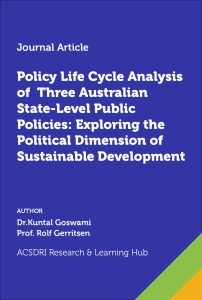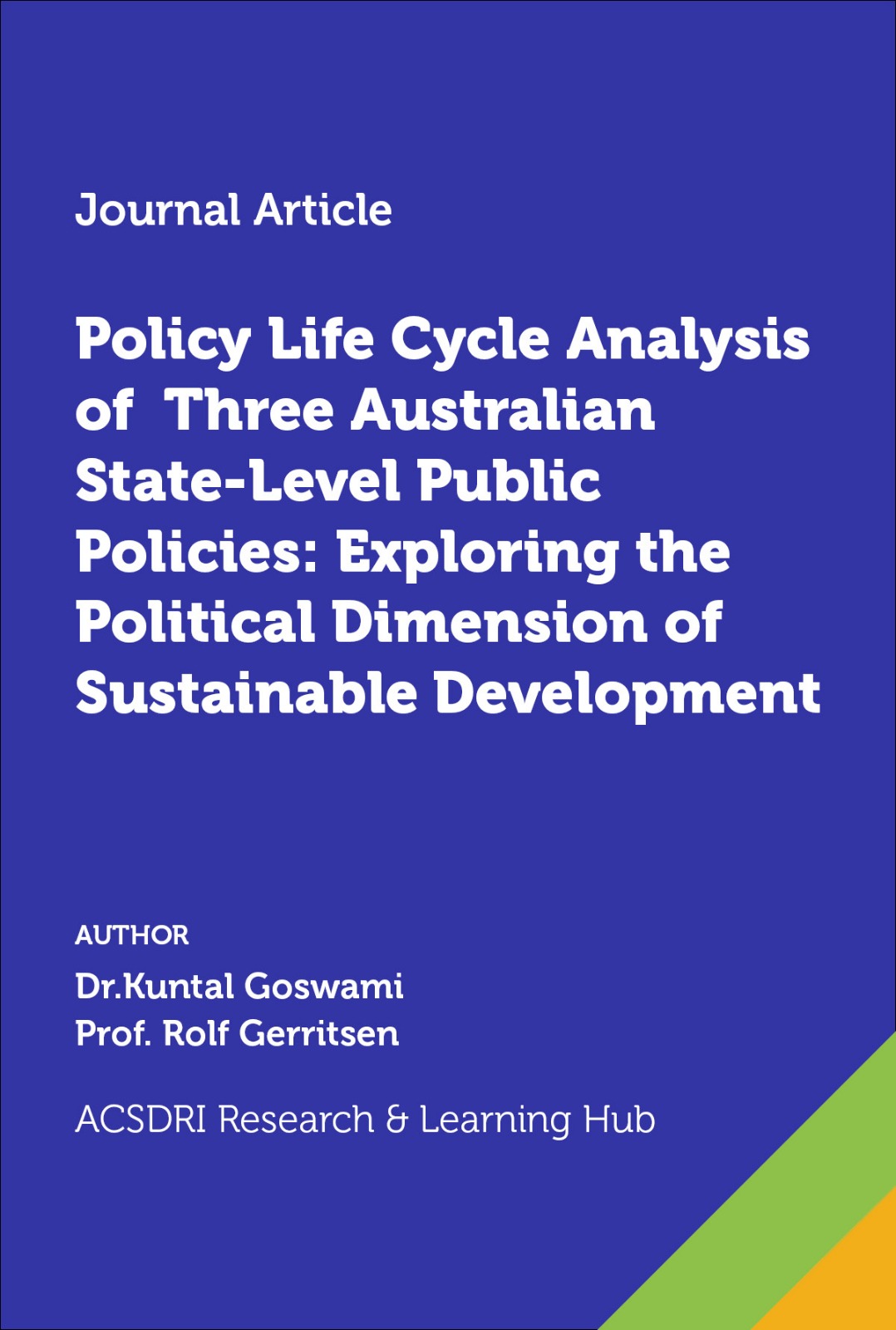Journal Articles
Policy Life Cycle Analysis of Three Australian State – level Public Policies : Exploring the Political Dimension of Sustainable Development
Sustainability Policy Life Cycle Analysis: Exploring the Political Dimension of Sustainable Development
Authors: Dr. Kuntal Goswami, ACSDRI and Prof Rolf Gerritsen
Abstract: This article analyzed the life cycle of three Australian public policies. These policies were formulated at the state level and were structured around sustainable development concepts (the economic, environmental, and social dimensions). Our study highlights the contexts that led to the making of these public policies and the factors that led to discontinuing these policies. Our case studies are based on analysis of parliamentary debates, state governments’ budget reports, public agencies’ annual reports, government media releases, and stakeholders’ feedback.
Impact statement: Our empirical findings highlight the importance of understanding sustainable development’s political dimension. This fact highlights the need to look beyond the traditional three-dimensional view of sustainability when assessing sustainable development policies’ success (or lack thereof). Equally important, our analysis indicated that despite limited success (and even without implementation), sustainability policies can have a legacy beyond their life-cycle. Hence, evaluating these policies is likely to provide insight into the policymaking process.
Keywords: Sustainability Policy Life cycle Analysis, Tasmania Together, South Australia’s Strategic Plan, Western Australia’s State Sustainability Strategy, Political Dimension of Sustainable Development, Sustainability Policy Legacy, Sustainable Development, Australian State Government
Goswami, K. and Gerritsen, R. (2021) ‘Policy Life Cycle Analysis of Three Australian State-level Public Policies: Exploring the Political Dimension of Sustainable Development’, Journal of Development Policy and Practice, 6(1), pp. 9–35. https://doi.org/10.1177/2455133321998805 and https://acsdri.com/publications-on-sustainable-development/sustainability-policy-life-cycle-analysis/
Introduction to Sustainability Policies
Every public policy tries to set out new norms and value systems. The public becomes aware of the new policy or system their government set out to implement through its press release, television, or newspaper. However, the question is, ‘Where did the initial idea come from?’; ‘Who had the idea in the first place?’; ‘Why did the agenda become politically important?’ and ‘How suddenly did the agenda lose its political relevance?’ In this article, we explored these questions in the process of analyzing the life-cycle of three Australian state-level policies: Tasmania Together (TT), South Australia’s Strategic Plan (the SASP), and Western Australia’s State Sustainability Strategy (WA’s SSS).
In Australia, from 1998 until the first half of the 2000s, all Labor-governed states adopted a strategic plan or strategy based on sustainable development values. The sustainable development concept is often explained from the triple bottom line perspective, combining economic, social, and environmental dimensions. However, to advance the sustainable development agenda, there is also a need to understand the political dimensions of sustainable development (O’Connor, 2006). The value systems underpinning sustainable development policies are, typically, an amalgamation of ‘hard facts’ regarding economic, social, and environmental dimensions and societal ‘gut feelings’ that represent a sense of responsibility for acting on environmental degradation. In addition to these facts, the desires of politicians and policymakers to make a mark in the sustainability policy area and to leave a legacy are also essential factors. Hence, the success of a sustainable development policy lies in its ability to mix and match these often-competing factors.
Even if a policy finds an optimal way to satisfy ‘hard facts’, societal desires, and politicians’ ambitions, it has its shelf-life. Thus, the real challenge for a sustainable development policy (and, for that matter, any public policy) lies in whether it can have a legacy after its shelf-life.
Hence, in this article, we examine the life cycle of three overarching sustainable development policies of the early 2000s: Tasmania Together (TT), South Australia’s Strategic Plan (the SASP), and Western Australia’s State Sustainability Strategy (WA’s SSS). In addition, we also briefly highlight what sort of legacies these policies have left behind from a stakeholders’ perspective.
State Strategic Planning in the International Context
Over the years, the sustainable development concept has been disseminated and accepted in many national, sub-national, and local jurisdictions (Quental & Lourenço, 2012). Our study contributes to the literature that focuses on sustainable development policies at the sub-national level – those jurisdictions between national and local levels of government (Marks et al., 2008). In the conventional three-tier democratic political structure that we can observe in many countries around the globe, the sub-national jurisdiction (usually called a state, province, or canton) is responsible for implementing a range of policies. This level of government often plays a vital role in developing and implementing sustainable development policies. For example, since the late 1980s, several US state governments and other sub-national jurisdictions have launched state-based strategic planning with holistic sustainability (economic–social–environmental) targets and benchmarks to guide public policies (Schumacher Center for a New Economics, 2012; Happaerts, 2012). However, the specific content of sustainable development policies is found to be intensely dependent on domestic conditions (Happaerts, 2012; Happaerts & Van Den Brande, 2011).
Happaerts and Van Den Brande (2011) have pointed out that major global summits on sustainable development, such as the Earth Summit in Rio de Janeiro in 1992 and the Earth Summit in Johannesburg in 2002 that followed from the Brundtland Commission Report of 1987 had an immense influence on the dissemination of sustainability values. In particular, the message expressed at these summits is that sustainable development is not necessarily a national government issue but has to resonate well with local and sub-national governments. Over the years, sub-national governments have shown a desire to participate in (international) sustainable development policy and governance, as is evidenced by both their ‘on-the-ground policies’ and their participation in transnational sustainable development and climate change governance networks (Happaerts & Van Den Brande, 2011). Not all sustainable development activities of sub-national governments can be explained by a ‘voluntary’ eagerness to do good (or to do better than their national context): national governments often mandate sub-national governments to develop, implement, and monitor the performance of sustainable development policies.
State Strategic Planning in the Australian Sub-National Context
Since the 1980s, public sector policymaking in Australia has been guided by the New Public Management (NPM) philosophy (Andrews & Van de Walle, 2013; Johnston, 2000). However, as the Labor Party came to power in most of the Australian states in the late 1990s or early 2000s, the narrow focus of an ‘agency-centric’ effectiveness approach was replaced by ‘whole-of-government’ strategic planning processes centered around sustainable development or holistic sustainability (economic, social, and environmental) values (Considine, O’Sullivan, & Nguyen, 2014; Gallop, 2007b; Johnstone, 2000). Many Australian state governments embraced strategic planning due to the change in perspective towards public governance. They incorporated holistic sustainability values or the triple bottom line approach as their core values (Gallop, 2007a, 2007b).
The process started in Queensland with the Beattie government’s adoption of the Smart State Plan in 1988 (Althaus, 2008; Tagliaferri, 2011). In 2001, the Bracks and the Bacon governments launched Growing Victoria Together and Tasmania Together in Victoria and Tasmania, respectively (Althaus, 2008; Tagliaferri, 2011). In 2004, the Rann government adopted South Australia’s Strategic Plan. In Western Australia, Better Planning: Better Services and the State Sustainability Strategy were launched by the Gallop government in 2003 (Martin & Christof, 2011; van Schoubroeck, 2010; Tagliaferri, 2011). Finally, in New South Wales, A New Direction for the Future was implemented in 2006 by the Iemma government (Gallop, 2007b; Tagliaferri, 2011).
Previous research on these state-level strategic plans concentrated on the perspectives mentioned in the summary below:
• Adams and Wiseman (2003) provided an insider’s perspective on why Growing Victoria Together was undertaken by the Victorian Labor government. The authors noted that formulating the strategic plan at the state level was an alternative policy paradigm to withstand an increasingly uncertain global environment.
• Crowley and Coffey (2007a, 2007b) conducted a comparative study of Tasmania Together and Growing Victoria Together. Their analysis suggested that Tasmania Together was created in an apolitical bottom-up process. The political priorities of Growing Victoria Together were intended to bring the social and environmental dimensions into the decision-making process.
• Nabben’s (2011) study on Growing Victoria Together highlighted how the Victorian Labor government tried from 1999 to 2006 to use strategic planning as a community development tool. Manwaring’s (2010) research on South Australia’s Strategic Plan evaluated the 2006 public consultation process to review the plan.
• Gallop (2007a, 2007b) saw state-level strategic planning as an alternative to the New Public Management policy model. He felt that if strategic planning was combined with the concept of sustainability, it would provide a robust framework for policymaking. Similarly, Crowley and Coffey (2007a) concluded that a state’s strategic plan could fulfill the sustainability agenda.
• Althaus (2008) pointed out that in each case, these states’ plans were initiated by Labor governments after a tight electoral contest that gave them a surprise win. Therefore, each state-level strategic plan made by Labor governments was a tool for managing political risks and a communication mechanism to manage the government’s credibility.
• Van Schoubroeck (2008) analyzed the perceptions of the Western Australian political and public sector actors in the Better Planning: Better Services program. The study revealed that adopting strategic planning at the state level was the new norm in the era of New Public Management.
• McMahon and Phillimore (2013) analyzed all the strategic plans the various state governments adopted between 2001 and 2011. Their study demonstrated how each state plan fulfilled its purpose and function as a monitoring, managing, and marketing tool.
Hence, our policy life-cycle study of three selected state-level public policies (TT, SASP, and WA’s SSS) adds a new perspective and advances the literature on Australian sub-national public policies. READ MORE




